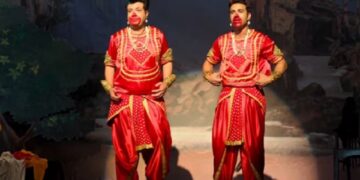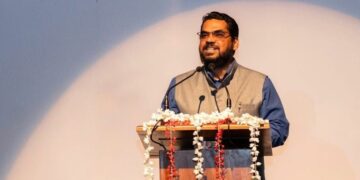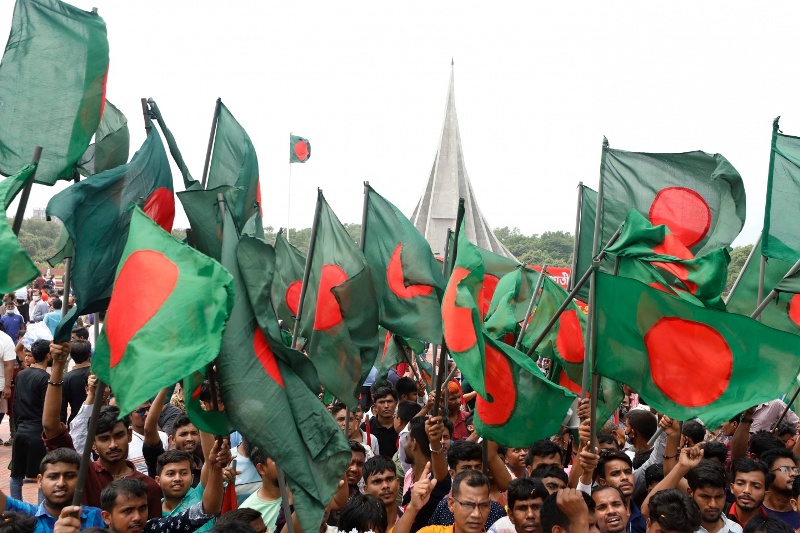The conspiracy that led to the fall of Sheikh Hasina’s government in August last year was once more a reminder of the vulnerabilities Bangladesh has been subject to since its emergence as a sovereign state in late 1971.
Therefore, the meticulously designed overthrow of the government eleven months ago, a fact Muhammad Yunus cheerfully brought to Bill Clinton’s attention on his visit to the US last September, was not the first time Bangladesh was laid low by intrigues manufactured both at home and abroad.
The latest instance of how Bangladesh is being pushed to increasingly horrendous levels of anarchy and uncertainty about the future was manifested the other day when the International Crimes Tribunal (ICT), a body which in the past prosecuted and convicted notorious collaborators of the Pakistan occupation army during the country’s War of Liberation in 1971, sentenced Sheikh Hasina to six months in prison.
The former prime minister, who has been in India since the fall of her government last year, has been convicted for contempt of court over statements she has recently made questioning the working of the tribunal under a new set-up put in place by the Yunus regime.
Her followers have predictably condemned the judgement. The judgement happens to be the first in the Yunus regime’s attempts to bring the former Bangladesh leader to what it calls justice.
The chaos the Yunus regime presides over in Bangladesh takes one back to the early years of Bangladesh’s independent status.
One recalls the disturbing fact of the local collaborators of the Pakistan occupation army lying low in the post-liberation period despite the triumph of the Bengalis in the 1971 war.
Though the government of Sheikh Mujibur Rahman initiated the process of a trial of the collaborators through the establishment of the International Crimes Tribunal in 1973, a very large number of Pakistan’s supporters went underground, waiting for the right moment to strike back. As passing times would show, they did strike back.
A particularly worrying trend in the early 1970s was the political volte-face of Moulana Abdul Hamid Khan Bhashani. Having been the first president of the Awami League in the 1950s, Bhashani left the party in 1957 and formed the National Awami Party (NAP) with an emphasis on leftist politics.
In 1971, Bhashani, in exile in India, served as an advisor to the Bangladesh government set up in Mujibnagar by Prime Minister Tajuddin Ahmad.
When one of his leading followers, Moshiur Rahman Jadu Mia, met him in Calcutta and urged him, with the blessings of the Yahya Khan regime, to return to ‘East Pakistan’, he angrily was dismissive of the suggestion.
However, by 1973, Bhashani had brought out a newspaper, Haq Katha, which engaged in sustained propaganda against the Mujib government. Worse, he began to publicly advocate the creation of a ‘Muslim Bangla’, which was a clear deviation from the secular ideals on which Bangladesh was founded in 1971.
This revisionist approach to politics by Bhashani encouraged not only anti-Awami League elements but also those who had actively opposed the collapse of Pakistan in Bangladesh.
When Bangabandhu Sheikh Mujibur Rahman was assassinated along with nearly his entire family in August 1975, Bhashani congratulated the soldiers for what he called saving the country.
Another cog in the wheel of conspiracy was the role of Abdul Haq, an extreme leftist politician unwilling to come to terms with the emergence of Bangladesh in 1971.
His political outfit undertook violent operations against the government in areas where he had groups of followers and thereby sought to destabilise the government.
Haq remains notorious for the letter he sent in a clandestine manner through his channels to Pakistani Prime Minister Zulfikar Ali Bhutto in 1974, seeking his assistance in finance and arms to overthrow what he referred to as the illegal Mujib government in Bangladesh.
Bhutto was cheered by the letter, reference to which appears in Stanley Wolpert’s biography of Pakistan’s leader, ‘Zulfi Bhutto of Pakistan.’ Abdul Haq emerged in public after the violent coup of 15 August 1975. No questions were asked about his past role in underground politics against the state of Bangladesh.
The conspiracy against Bangladesh, always a focused and sustained affair by those who undertook it, was initiated soon after the Pakistan army surrendered to the joint command of the Mukti Bahini and the Indian army on 16 December 1971.
Prior to the liberation of Bangladesh, a good number of right-wing, pro-Pakistan Bengali politicians travelled to Rawalpindi for consultations with General Yahya Khan.
They were stranded in Pakistan with the outbreak of the war between India and Pakistan on 3 December.
Soon after taking over as Pakistan’s President on 20 December 1971, Zulfikar Ali Bhutto appointed the Bengali Nurul Amin as his vice president.
More worryingly, he despatched Ghulam Azam, who had headed the Jamaat-e-Islami in ‘East Pakistan’, to the Middle East to disseminate false propaganda against the Mujib government in Bangladesh.
Azam spread the falsehood that Bangladesh’s secular government had been persecuting Muslims in the country.
Ghulam Azam travelled to Bangladesh on a Pakistani passport and a visa issued by the Bangladesh mission in Pakistan in 1978.
Despite the expiry of his visa, he did not return to Pakistan but stayed on in Bangladesh, raising questions about the failure or reluctance of the Ziaur Rahman military regime to prosecute him.
Azam was years later tried and convicted on charges of committing crimes against humanity by the ICT. He died as a convict in the times of the Sheikh Hasina government.
Another Bangladeshi, Tridiv Roy, king of the Chakmas, threw in his lot with the Yahya Khan regime in 1971 and stayed on in Pakistan after December 1971.
The Bhutto government appointed him a minister and despatched him to the United Nations in September 1972 to argue Pakistan’s case against Bangladesh’s admission to the world body.
Following the war in 1971, a group of fanatical pro-Pakistani Bengalis formed a group in the United Kingdom that had for its objective the restoration of ‘East Pakistan’.
Nothing much came of it and it died a slow but sure death. Meanwhile, back in Bangladesh, increasing lawlessness compounded an already worsening economic condition.
A famine in 1974 led to a very large number of deaths, but the Bangladesh government’s appeal to the United States for food aid was not immediately responded to. Besides, the US administration turned away a ship on the high seas which carried food aid for Bangladesh because Bangladesh had been trying to engage in trade with Cuba despite the provisions of the PL-480 programme.
Conspiracies against Bangladesh gained momentum towards the end of the government of Bangabandhu Sheikh Mujibur Rahman in 1975. Beginning in the later part of 1974, some mid-ranking officers, serving as well as retired, of the Bangladesh army linked up with US embassy officials, especially the CIA station chief at the embassy, to solicit Washington’s support for a political change in Dhaka.
Mujib’s assassination was swiftly followed by the Bhutto government’s recognition of the usurper regime of Khondokar Moshtaq Ahmed and a despatch of rice and cloth for Bangladesh.
Indeed, the very act of the bloody overthrow of Bangabandhu’s government was a dire result of the intrigue indulged in by Moshtaq and the renegade majors and colonels supporting him.
The conspiracy of 15 August was followed barely three months later by another when four prominent associates of Bangabandhu who had led the armed struggle for freedom as leaders of the Mujibnagar government were murdered on 3 November 1975 in Dhaka Central Jail, where they had been incarcerated.
Conspiracy took a new turn in the post-Mujib era through the propagation of a so-called Bangladeshi nationalism by the military regime of General Ziaur Rahman.
It was a patent attempt to undermine the four cardinal principles underpinning the War of Liberation — democracy, secularism, socialism, nationalism — and which formed the spirit of Bengali nationalism.
Conspiratorial politics took a new dimension with the coup d’etat staged by General Hussein Muhammad Ershad, the army chief, in March 1982. The new military ruler deepened Bangladesh’s malaise by declaring Islam as the religion of the state.
Suspicions about the results of the general election of 1986 called by the Ershad regime have lingered. The live telecast of the election results showed the Awami League doing well, threatening the position of Ershad’s newly formed Jatiya Party.
However, at some point the live telecast was stopped and when the results were finally announced, they revealed that the Awami League had lost.
Again, in October 2001, the suspicious manner in which all eight parliamentary seats in the capital Dhaka were lost by the Awami League was telling.
The result was the formation of the government by a BNP-Jamaat coalition.
If in 1975 the objective of those opposed to the War of Liberation was to wipe out the senior leadership of the Awami League, in 2004 their aim was clearly to commit a similar act.
On 21 August, grenade explosions at an Awami League rally in Dhaka led to the death of twenty-four people and injuries to scores of others. Sheikh Hasina survived the blast, but senior party leader Ivy Rahman did not.
Given all this background of conspiracy against Bangladesh following the emergence of the country, it does not surprise anyone that the fall of the Awami League government in August 2024 was brought about through a well-laid web of intrigue targeting the nationalist spirit of the country and its economic progress.
ALSO READ: Bangladesh: Where the mob rules, where politics is fugitive
The conspiracy, it has been becoming evident by slow but sure degrees, involved homegrown individuals aided by their patrons abroad.
The difference between past intrigues and the one reaching fruition in 2024 is that in these present times it is now a frontal assault on the state and its history, heritage and institutions that Bangladesh’s people have fallen prey to.
The enemy within has been at work since August last year.















